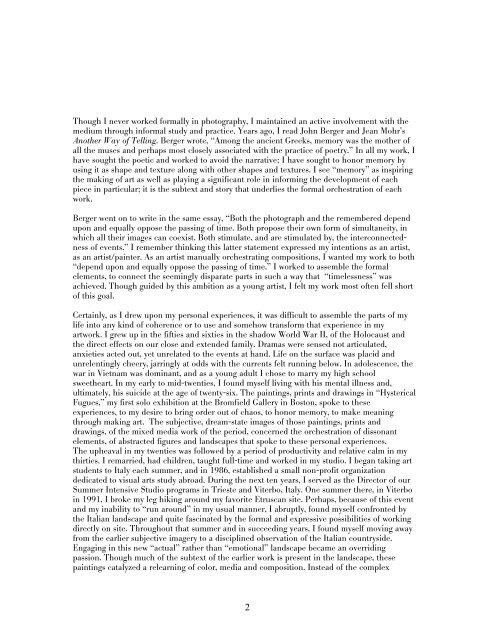SECTION 1 - via - School of Visual Arts
SECTION 1 - via - School of Visual Arts
SECTION 1 - via - School of Visual Arts
Create successful ePaper yourself
Turn your PDF publications into a flip-book with our unique Google optimized e-Paper software.
Though I never worked formally in photography, I maintained an active involvement with the<br />
medium through informal study and practice. Years ago, I read John Berger and Jean Mohr’s<br />
Another Way <strong>of</strong> Telling. Berger wrote, “Among the ancient Greeks, memory was the mother <strong>of</strong><br />
all the muses and perhaps most closely associated with the practice <strong>of</strong> poetry.” In all my work, I<br />
have sought the poetic and worked to avoid the narrative; I have sought to honor memory by<br />
using it as shape and texture along with other shapes and textures. I see “memory” as inspiring<br />
the making <strong>of</strong> art as well as playing a significant role in informing the development <strong>of</strong> each<br />
piece in particular; it is the subtext and story that underlies the formal orchestration <strong>of</strong> each<br />
work.<br />
Berger went on to write in the same essay, “Both the photograph and the remembered depend<br />
upon and equally oppose the passing <strong>of</strong> time. Both propose their own form <strong>of</strong> simultaneity, in<br />
which all their images can coexist. Both stimulate, and are stimulated by, the interconnectedness<br />
<strong>of</strong> events.” I remember thinking this latter statement expressed my intentions as an artist,<br />
as an artist/painter. As an artist manually orchestrating compositions, I wanted my work to both<br />
“depend upon and equally oppose the passing <strong>of</strong> time.” I worked to assemble the formal<br />
elements, to connect the seemingly disparate parts in such a way that “timelessness” was<br />
achieved. Though guided by this ambition as a young artist, I felt my work most <strong>of</strong>ten fell short<br />
<strong>of</strong> this goal.<br />
Certainly, as I drew upon my personal experiences, it was difficult to assemble the parts <strong>of</strong> my<br />
life into any kind <strong>of</strong> coherence or to use and somehow transform that experience in my<br />
artwork. I grew up in the fifties and sixties in the shadow World War II, <strong>of</strong> the Holocaust and<br />
the direct effects on our close and extended family. Dramas were sensed not articulated,<br />
anxieties acted out, yet unrelated to the events at hand. Life on the surface was placid and<br />
unrelentingly cheery, jarringly at odds with the currents felt running below. In adolescence, the<br />
war in Vietnam was dominant, and as a young adult I chose to marry my high school<br />
sweetheart. In my early to mid-twenties, I found myself living with his mental illness and,<br />
ultimately, his suicide at the age <strong>of</strong> twenty-six. The paintings, prints and drawings in “Hysterical<br />
Fugues,” my first solo exhibition at the Bromfield Gallery in Boston, spoke to these<br />
experiences, to my desire to bring order out <strong>of</strong> chaos, to honor memory, to make meaning<br />
through making art. The subjective, dream-state images <strong>of</strong> those paintings, prints and<br />
drawings, <strong>of</strong> the mixed media work <strong>of</strong> the period, concerned the orchestration <strong>of</strong> dissonant<br />
elements, <strong>of</strong> abstracted figures and landscapes that spoke to these personal experiences.<br />
The upheaval in my twenties was followed by a period <strong>of</strong> productivity and relative calm in my<br />
thirties. I remarried, had children, taught full-time and worked in my studio. I began taking art<br />
students to Italy each summer, and in 1986, established a small non-pr<strong>of</strong>it organization<br />
dedicated to visual arts study abroad. During the next ten years, I served as the Director <strong>of</strong> our<br />
Summer Intensive Studio programs in Trieste and Viterbo, Italy. One summer there, in Viterbo<br />
in 1991, I broke my leg hiking around my favorite Etruscan site. Perhaps, because <strong>of</strong> this event<br />
and my inability to “run around” in my usual manner, I abruptly, found myself confronted by<br />
the Italian landscape and quite fascinated by the formal and expressive possibilities <strong>of</strong> working<br />
directly on site. Throughout that summer and in succeeding years, I found myself moving away<br />
from the earlier subjective imagery to a disciplined observation <strong>of</strong> the Italian countryside.<br />
Engaging in this new “actual” rather than “emotional” landscape became an overriding<br />
passion. Though much <strong>of</strong> the subtext <strong>of</strong> the earlier work is present in the landscape, these<br />
paintings catalyzed a relearning <strong>of</strong> color, media and composition. Instead <strong>of</strong> the complex<br />
2








